Four Storm Surge Cases on the Coast of São Paulo, Brazil: Weather Analyses and High-Resolution Forecasts
Abstract
:1. Introduction
2. Materials and Methods
2.1. The Storm Surge Cases
- Severe events (very rough sea): These are characterized by strong to extremely strong waves. The primary impact is coastal and beach erosion, with only localized coastal flooding.
- Severe events (storm tide): These events are characterized by a combination of storm surges and high tides [21]; the worst scenario occurs when a strong storm surge coincides with the spring tide peak, resulting in higher storm tides. The primary impact is coastal flooding along the seafront, with less beach erosion.
- Extreme events (storm tide + rough sea): These events occur when both types of severe events occur simultaneously. They cause significant coastal erosion and major coastal flooding along both the seafront and estuarine/lagoonal shorelines, especially when associated with heavy rainfall.
2.2. Eta Model Setup
3. Results
3.1. Observations
Large-Scale Meteorological Conditions
3.2. Forecasts
3.2.1. MSLP and 10 m Wind Mesoscale Patterns
3.2.2. Precipitation Patterns
3.3. Offshore Time Series
3.4. Forecast Skill
3.4.1. MSLP Evaluation
3.4.2. The 10-m Wind Speed Evaluation
3.4.3. Precipitation Evaluation
4. Discussion
5. Conclusions
Author Contributions
Funding
Data Availability Statement
Acknowledgments
Conflicts of Interest
References
- IBGE. Censo Demográfico 2022; Instituto Brasileiro de Geografia e Estatística (IBGE): Rio de Janeiro, Brazil, 2022. [Google Scholar]
- Gramcianinov, C.B.; Campos, R.M.; de Camargo, R.; Hodges, K.I.; Guedes Soares, C.; da Silva Dias, P.L. Analysis of Atlantic Extratropical Storm Tracks Characteristics in 41 Years of ERA5 and CFSR/CFSv2 Databases. Ocean. Eng. 2020, 216, 108111. [Google Scholar] [CrossRef]
- Souza, C.R.d.G.; Souza, A.P.; Harari, J. Long Term Analysis of Meteorological-Oceanographic Extreme Events for the Baixada Santista Region. In Climate Change in Santos Brazil: Projections, Impacts and Adaptation Options; Springer International Publishing: Cham, Switzerland, 2019; pp. 97–134. [Google Scholar]
- Souza, C.R.G.; Silva, P.L.; Silva, V.D.M. Histórico de Eventos Meteorológicos-Oceanográficos Intensos/Extremos Na Costa de São Paulo (Brasil): 1928–2021. In Proceedings of the XIX Congresso Latino-Americano de Ciências Marinhas—COLACMAR: Panamá City, Panama, 19–23 September 2022; p. 245. [Google Scholar]
- Sondermann, M.; Chou, S.C.; Souza, C.R.d.G.; Rodrigues, J.; Caprace, J.D. Atmospheric Patterns Favourable to Storm Surge Events on the Coast of São Paulo State, Brazil. Nat. Hazards 2023, 117, 93–111. [Google Scholar] [CrossRef]
- Sondermann, M.; Chou, S.C.; Tavares, P.; Lyra, A.; Marengo, J.A.; Souza, C.R.d.G. Projections of Changes in Atmospheric Conditions Leading to Storm Surges along the Coast of Santos, Brazil. Climate 2023, 11, 176. [Google Scholar] [CrossRef]
- Nobre, P.; Siqueira, L.S.P.; de Almeida, R.A.F.; Malagutti, M.; Giarolla, E.; Castelão, G.P.; Bottino, M.J.; Kubota, P.; Figueroa, S.N.; Costa, M.C.; et al. Climate Simulation and Change in the Brazilian Climate Model. J. Clim. 2013, 26, 6716–6732. [Google Scholar] [CrossRef]
- Chou, S.-C.; Marengo, J.A.; Silva, A.J.; Lyra, A.A.; Tavares, P.; Souza, C.R.G.; Harari, J.; Nunes, L.H.; Greco, R.; Hosokawa, E.K.; et al. Projections of Climate Change in the Coastal Area of Santos. In Climate Change in Santos Brazil: Projections, Impacts and Adaptation Options; Springer International Publishing: Cham, Switzerland, 2019; pp. 59–73. [Google Scholar]
- Armani, G.; Beserra de Lima, N.G.; Pelizzon Garcia, M.F.; de Lima Carvalho, J. Regional Climate Projections for the State of São Paulo, Brazil, in the 2020–2050 Period. Derbyana 2022, 43, e773. [Google Scholar] [CrossRef]
- Ruiz, M.S.; Ribeiro, R.B.; Sampaio, A.F.P.; Harari, J.; Chou, S.C.; Chagas, D.J.; Ferreira, R.S.; Marinho, C.; Oliveira, F.; Souza, C.R.G. Previsão Operacional de Ressacas e Inundações Costeiras No Litoral de São Paulo. In Proceedings of the XV Simpósio sobre Ondas, Marés, Engenharia Oceânica e Oceanografia por Satélite, Cabo Frio, Brazil, 27–30 November 2023. [Google Scholar]
- Ruiz, M.S.; Harari, J.; Ribeiro, R.B.; Sampaio, A.F.P. Numerical Modelling of Storm Tides in the Estuarine System of Santos, São Vicente and Bertioga (SP, Brazil). Reg. Stud. Mar. Sci. 2021, 44, 101791. [Google Scholar] [CrossRef]
- Ribeiro, R.B.; Sampaio, A.F.P.; Ruiz, M.S.; Leitão, J.C.; Leitão, P.C. First Approach of a Storm Surge Early Warning System for Santos Region. In Climate Change in Santos Brazil: Projections, Impacts and Adaptation Options; Springer International Publishing: Cham, Switzerland, 2019; pp. 135–157. [Google Scholar]
- Ribeiro, R.B.; Ruiz, M.S.; Sampaio, A.F.P.; Oliveira, F.R.; Santos, A.J.; Borges, J.dM.; Pires, C.P. IARA-BS|Implantação Do Sistema de Alerta Para Ressacas e Alagamentos Na Baixada Santista. In Proceedings of the XXIV Encontro Nacional dos Comitês de Bacias Hidrográficas, Foz do Iguaçu, Brazil, 22–26 December 2022. [Google Scholar]
- Deltares. Delft3D-FLOW. Simulation of Multi-Dimensional Hydrodynamic Flows and Transport Phenomena, Including Sediments; Deltares: Delft, The Netherlands, 2023. [Google Scholar]
- Deltares. Delft3D-WAVE. Simulation of Short-Crested Waves with SWAN; Delft Hydraulics: Delft, The Netherlands, 2023. [Google Scholar]
- Egbert, G.D.; Erofeeva, S.Y. Efficient Inverse Modeling of Barotropic Ocean Tides. J. Atmos. Ocean Technol. 2002, 19, 183–204. [Google Scholar] [CrossRef]
- Chune, S.L.; Nouel, F.; Fernandez, E.; Derval, C.; Tressol, M. Global Ocean Sea Physical Analysis and Forecasting Products. Product User Manual. Issue 1.5. Copernicus Marine Environment Monitoring Service, 2020. Available online: https://catalogue.marine.copernicus.eu/documents/PUM/CMEMS-GLO-PUM-001-024.pdf (accessed on 24 April 2024).
- Lin, L.; Demirbilek, Z.; Mase, H.; Yamada, F.; Zheng, J. CMS-Wave: A Nearshore Spectral Wave Processes Model for Coastal Inlets and Navigation Projects; US Army Corps of Engineers Engineer Research and Development Center. Technical Report 8–13, USA, 2008. Available online: https://www.researchgate.net/publication/235088278_CMS-Wave_A_Nearshore_Spectral_Wave_Processes_Model_for_Coastal_Inlets_and_Navigation_Projects (accessed on 24 April 2024).
- Mesinger, F.; Chou, S.C.; Gomes, J.L.; Jovic, D.; Bastos, P.; Bustamante, J.F.; Lazic, L.; Lyra, A.A.; Morelli, S.; Ristic, I.; et al. An Upgraded Version of the Eta Model. Meteorol. Atmos. Phys. 2012, 116, 63–79. [Google Scholar] [CrossRef]
- Gomes, J.L.; Chou, S.C.; Mesinger, F.; Lyra, A.A.; Rodrigues, D.C.; Rodriguez, D.A.; Campos, D.A.; Chagas, D.J.; Medeiros, G.S.; Pilotto, I.; et al. Manual Modelo Eta-versão 1.4.2. INPE. São José dos Campos, SP, Brazil, 2023; ISBN 978-65-89159-08-7. Available online: http://urlib.net/8JMKD3MGP3W34T/48G6PU5 (accessed on 24 April 2024).
- Neumann, B.; Vafeidis, A.T.; Zimmermann, J.; Nicholls, R.J. Future Coastal Population Growth and Exposure to Sea-Level Rise and Coastal Flooding—A Global Assessment. PLoS ONE 2015, 10, e0118571. [Google Scholar] [CrossRef]
- Hersbach, H.; Bell, B.; Berrisford, P.; Hirahara, S.; Horányi, A.; Muñoz-Sabater, J.; Nicolas, J.; Peubey, C.; Radu, R.; Schepers, D.; et al. The ERA5 Global Reanalysis. Q. J. R. Meteorol. Soc. 2020, 146, 1999–2049. [Google Scholar] [CrossRef]
- Janjic, Z.I.; Gerrity, J.P.; Nickovic, S. An Alternative Approach to Nonhydrostatic Modeling. Mon. Weather Rev. 2001, 129, 1164–1178. [Google Scholar] [CrossRef]
- Betts, A.K.; Miller, M.J. A New Convective Adjustment Scheme. Part II: Single Column Tests Using GATE Wave, BOMEX, ATEX and Arctic Air-mass Data Sets. Q. J. R. Meteorol. Soc. 1986, 112, 693–709. [Google Scholar] [CrossRef]
- Janjić, Z.I. The Step-Mountain Eta Coordinate Model: Further Developments of the Convection, Viscous Sublayer, and Turbulence Closure Schemes. Mon. Weather Rev. 1994, 122, 927–945. [Google Scholar] [CrossRef]
- Ferrier, B.S.; Jin, Y.; Lin, Y.; Black, T.; Rogers, E.; Dimego, G. Implementation of a New Grid-Scale Cloud and Precipitation Scheme in the NCEP Eta Model. In Proceedings of the 15th Conference on Numerical Weather Prediction; American Meteorological Society: San Antonio, TX, USA, 2022; pp. 280–283. [Google Scholar]
- Fels, S.B.; Schwarzkopf, M.D. The Simplified Exchange Approximation: A New Method for Radiative Transfer Calculations. J. Atmos. Sci. 1975, 32, 1475–1488. [Google Scholar] [CrossRef]
- Lacis, A.A.; Hansen, J. A Parameterization for the Absorption of Solar Radiation in the Earth’s Atmosphere. J. Atmos. Sci. 1974, 31, 118–133. [Google Scholar] [CrossRef]
- Ek, M.B.; Mitchell, K.E.; Lin, Y.; Rogers, E.; Grunmann, P.; Koren, V.; Gayno, G.; Tarpley, J.D. Implementation of Noah Land Surface Model Advances in the National Centers for Environmental Prediction Operational Mesoscale Eta Model. J. Geophys. Res. Atmos. 2003, 108, 2002JD003296. [Google Scholar] [CrossRef]
- Mellor, G.L.; Yamada, T. A Hierarchy of Turbulence Closure Models for Planetary Boundary Layers. J. Atmos. Sci. 1974, 31, 1791–1806. [Google Scholar] [CrossRef]
- Paulson, C.A. The Mathematical Representation of Wind Speed and Temperature Profiles in the Unstable Atmospheric Surface Layer. J. Appl. Meteorol. 1970, 9, 857–861. [Google Scholar] [CrossRef]
- Charnock, H. Wind Stress on a Water Surface. Q. J. R. Meteorol. Soc. 1955, 81, 639–640. [Google Scholar] [CrossRef]
- National Centers for Environmental Prediction/National Weather Service/NOAA/U.S. Department of Commerce. 2015, Updated Daily. NCEP GFS 0.25 Degree Global Forecast Grids Historical Archive. Research Data Archive at the National Center for Atmospheric Research, Computational and Information Systems Laboratory. Available online: https://rda.ucar.edu/datasets/ds084.1/(accessed on 1 May 2024).
- Rozante, J.R.; Moreira, D.S.; de Goncalves, L.G.G.; Vila, D.A. Combining TRMM and Surface Observations of Precipitation: Technique and Validation over South America. Weather Forecast. 2010, 25, 885–894. [Google Scholar] [CrossRef]
- Wilks, D.S. Statistical Methods in Atmospheric Science, 2nd ed.; Academic Press: Cambridge, MA, USA, 2006. [Google Scholar]
- Calado, R.N.; Dereczynski, C.P.; Chou, S.C.; Sueiro, G.; Oliveira Moura, J.D.d.; da Silva Santos, V.R. Avaliação Do Desempenho Das Simulações Por Conjunto Do Modelo Eta-5 km Para o Caso de Chuva Intensa Na Bacia Do Rio Paraíba Do Sul Em Janeiro de 2000. Rev. Bras. Meteorol. 2018, 33, 83–96. [Google Scholar] [CrossRef]
- Reboita, M. Ciclones Extratropicais Sobre o Atlântico Sul: Simulação Climática e Experimentos de Sensibilidade. Ph.D. Thesis, University of São Paulo, São Paulo, Brazil, 2008. [Google Scholar]
- Gan, M.A.; Rao, V.B. Surface Cyclogenesis over South America. Mon. Weather Rev. 1991, 119, 1293–1302. [Google Scholar] [CrossRef]
- Sanders, F.; Gyakum, J.R. Synoptic-Dynamic Climatology of the “Bomb”. Mon. Weather Rev. 1980, 108, 1589–1606. [Google Scholar] [CrossRef]
- Cardoso, A.A. Ciclones Subtropicais e Ventos em Superfície no Sudoeste do Oceano Atlântico Sul: Climatologia e Extremos. Ph.D. Thesis, University of São Paulo, São Paulo, Brazil, 2019. [Google Scholar]
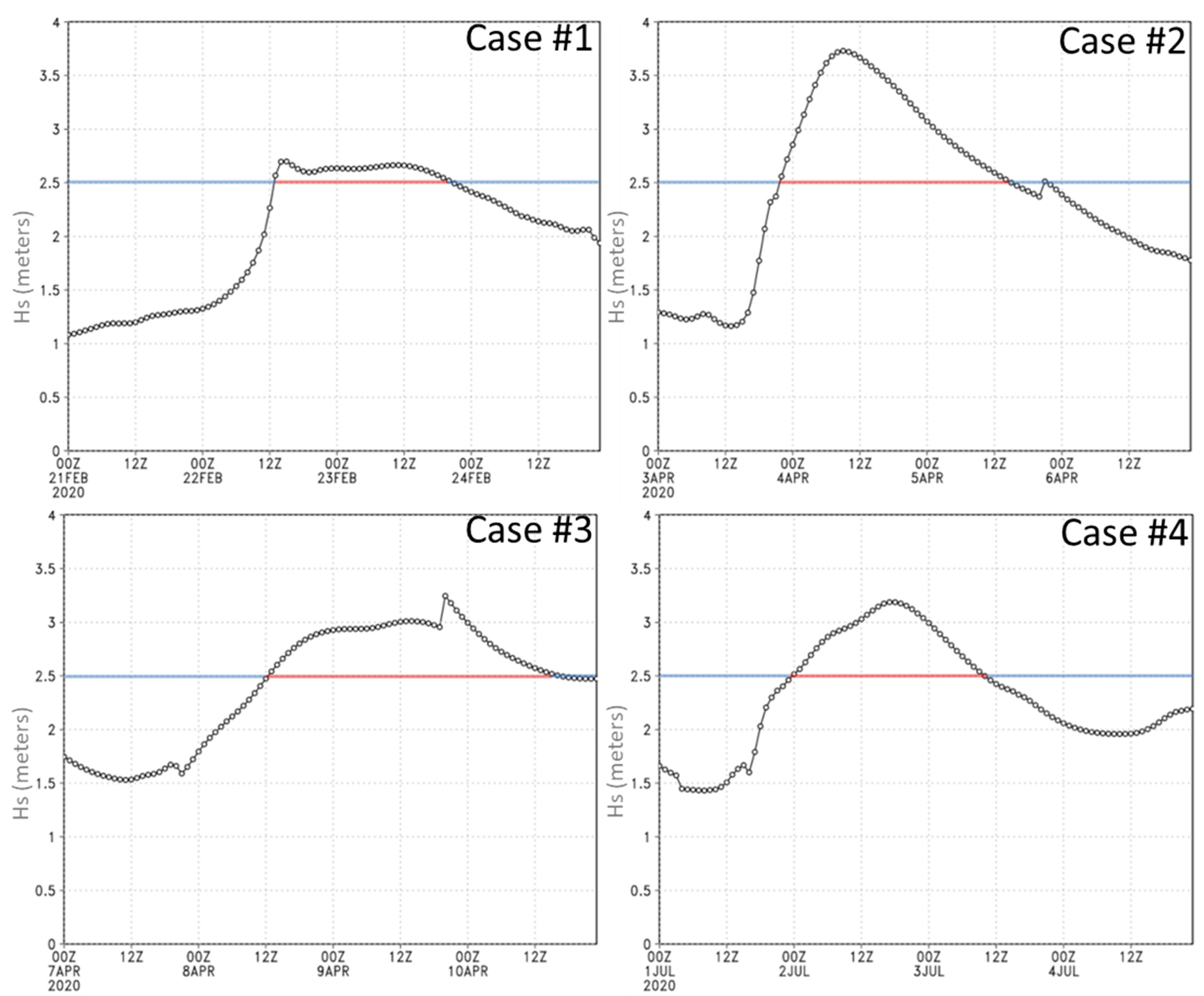
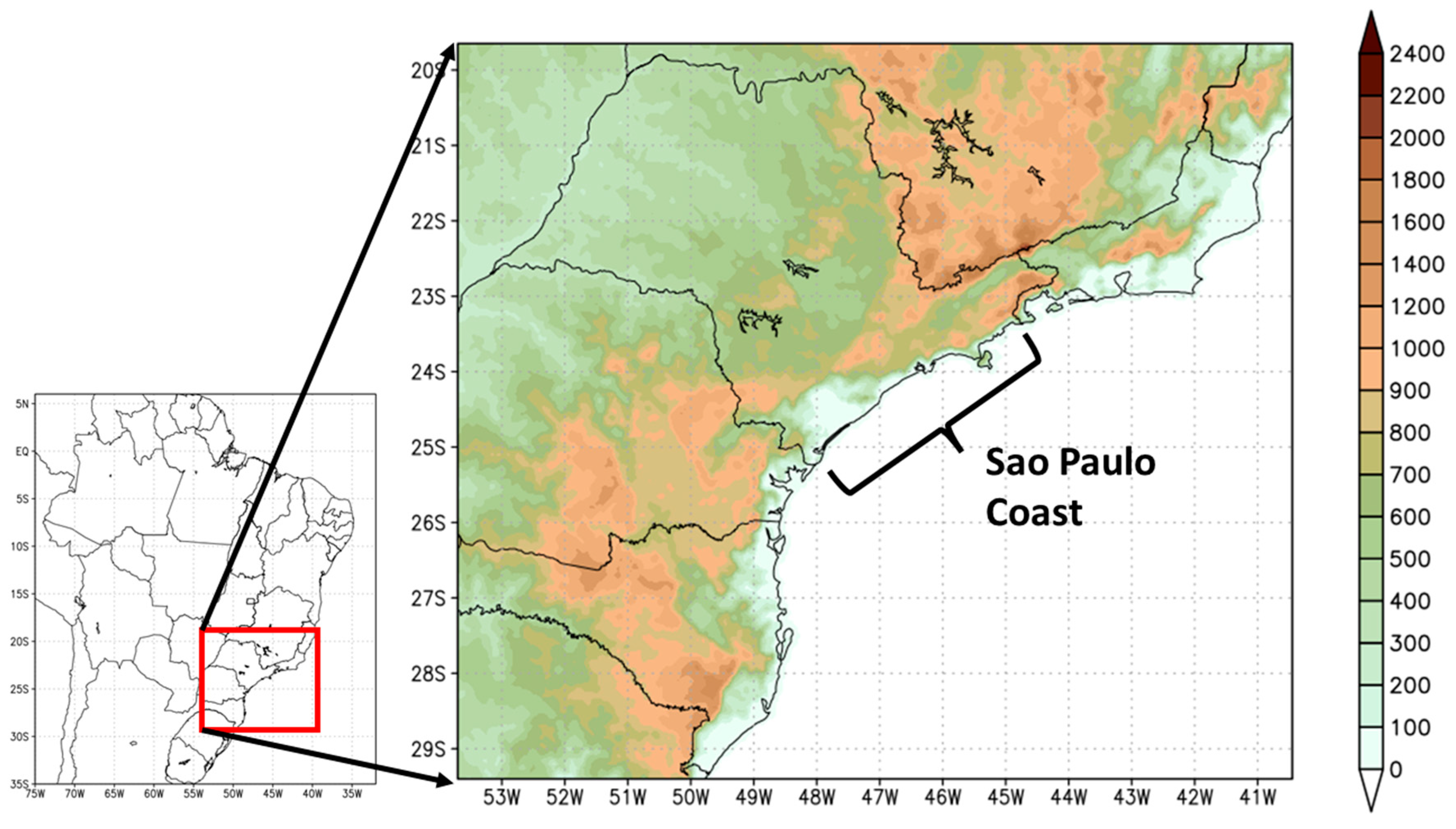
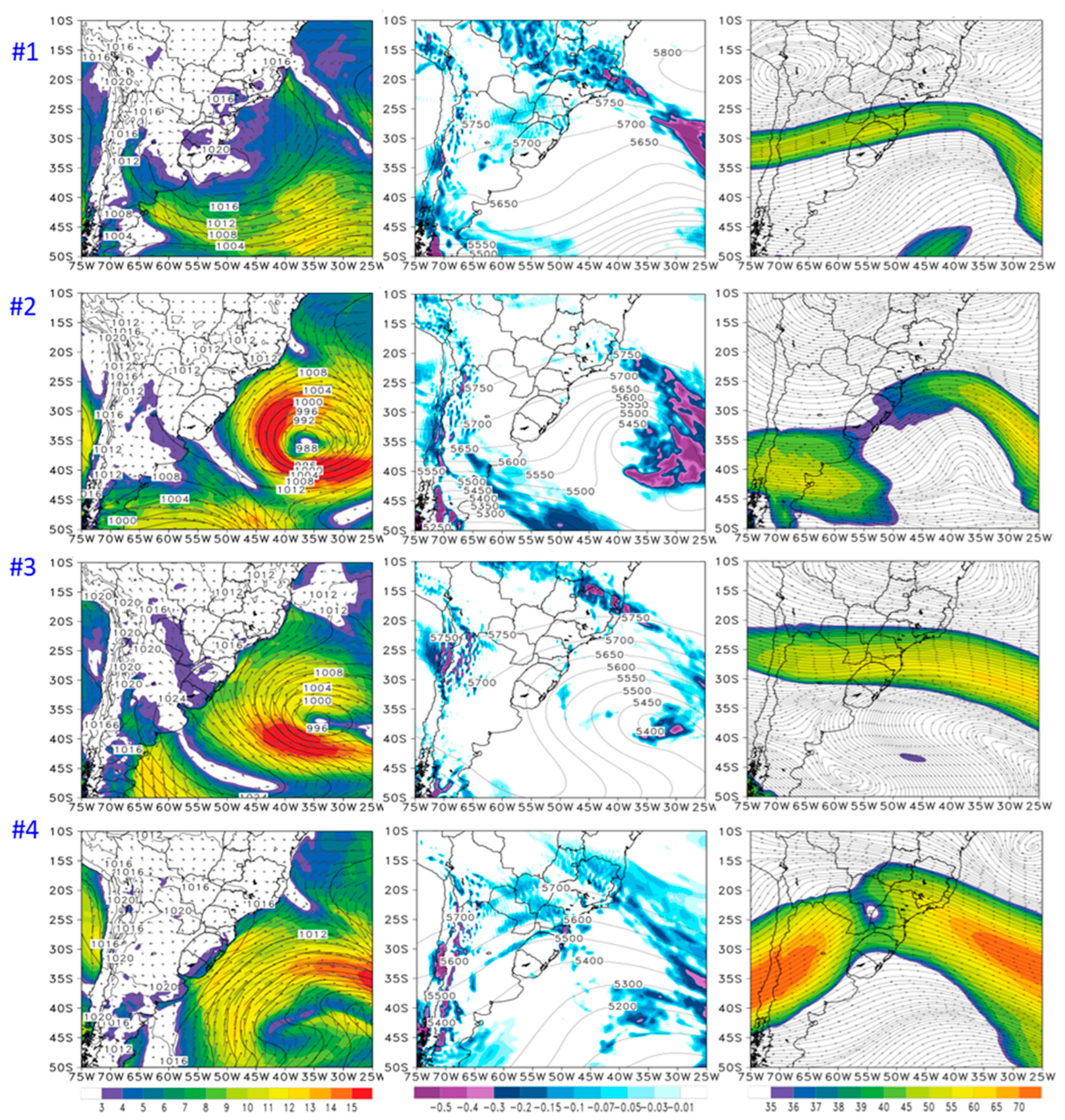
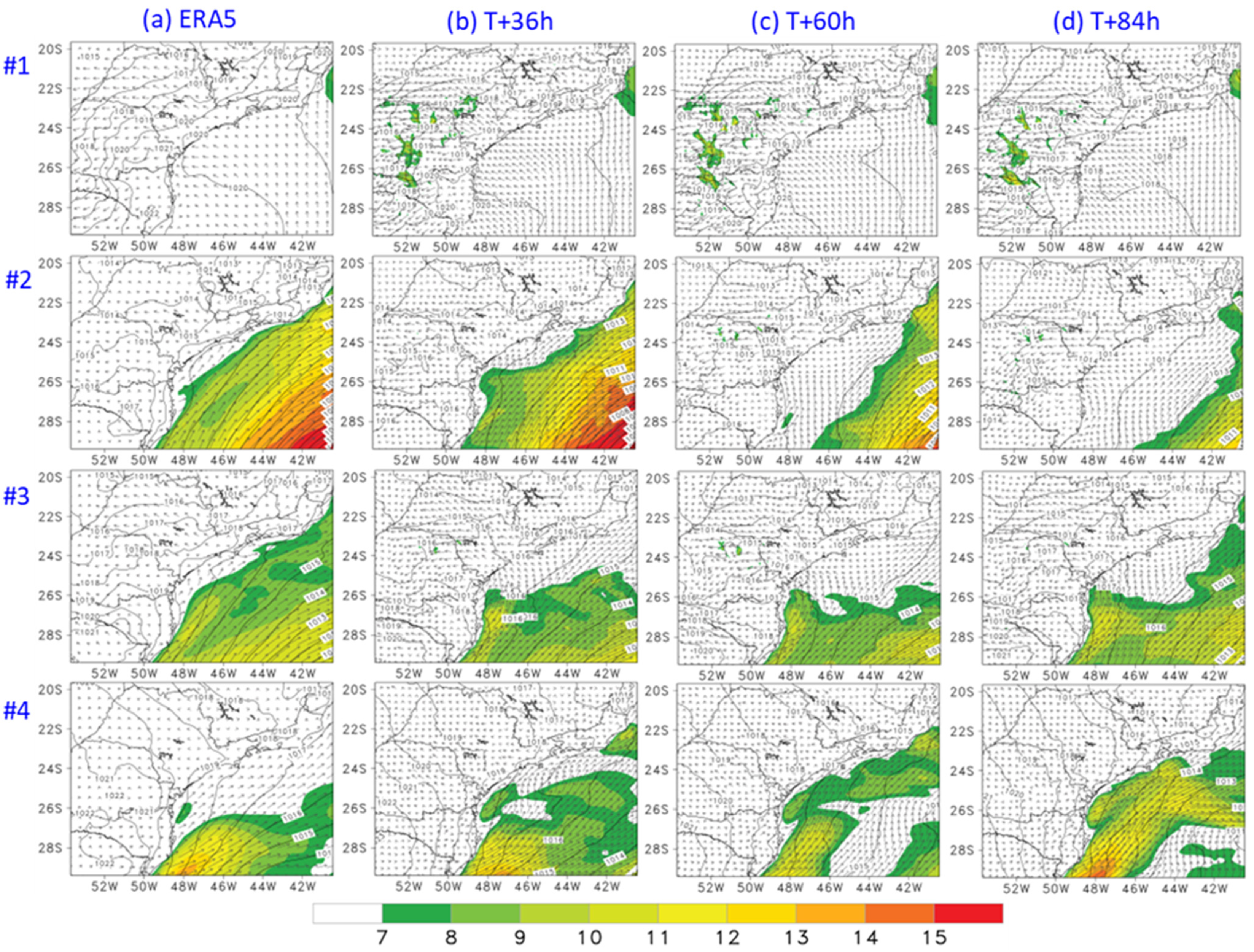
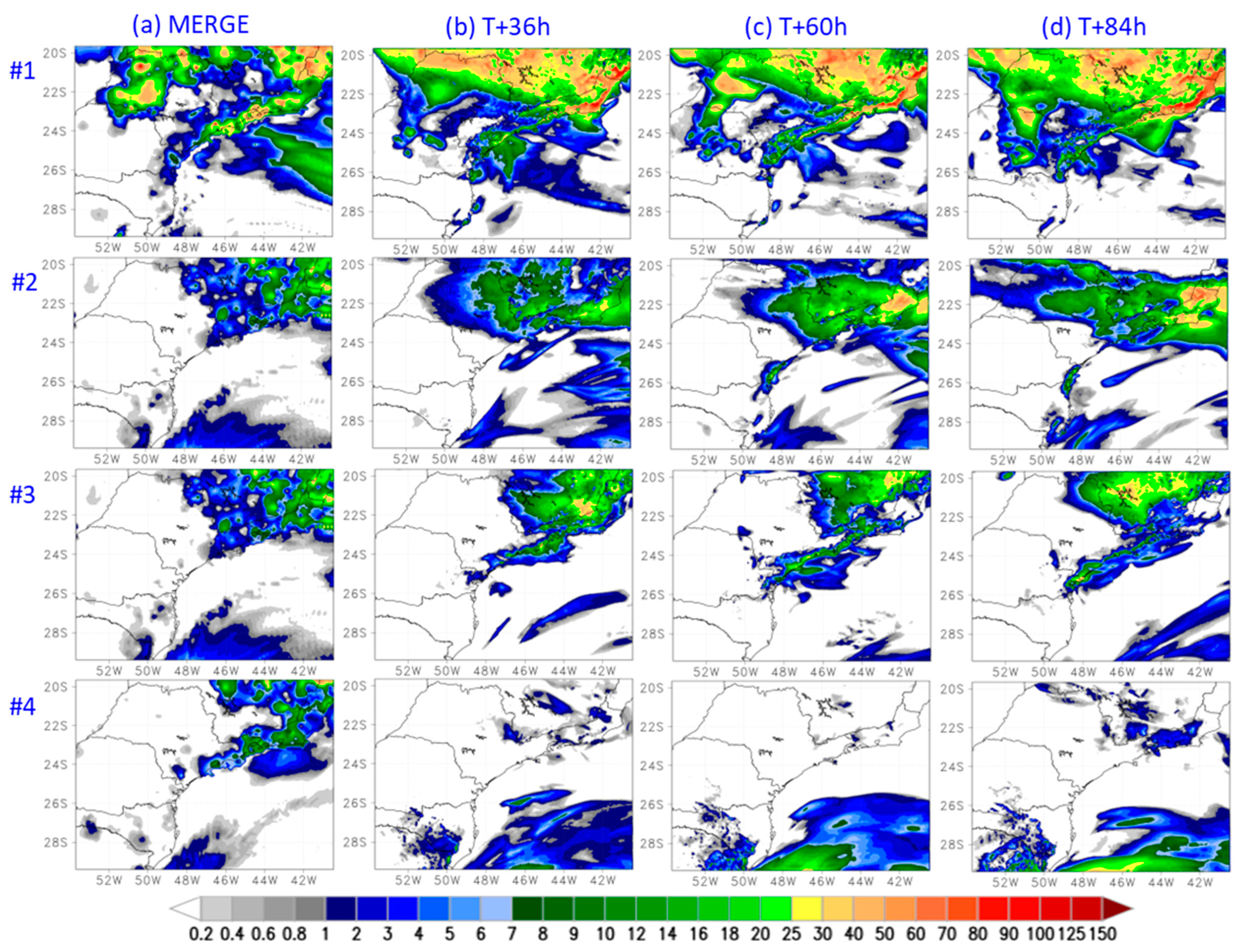
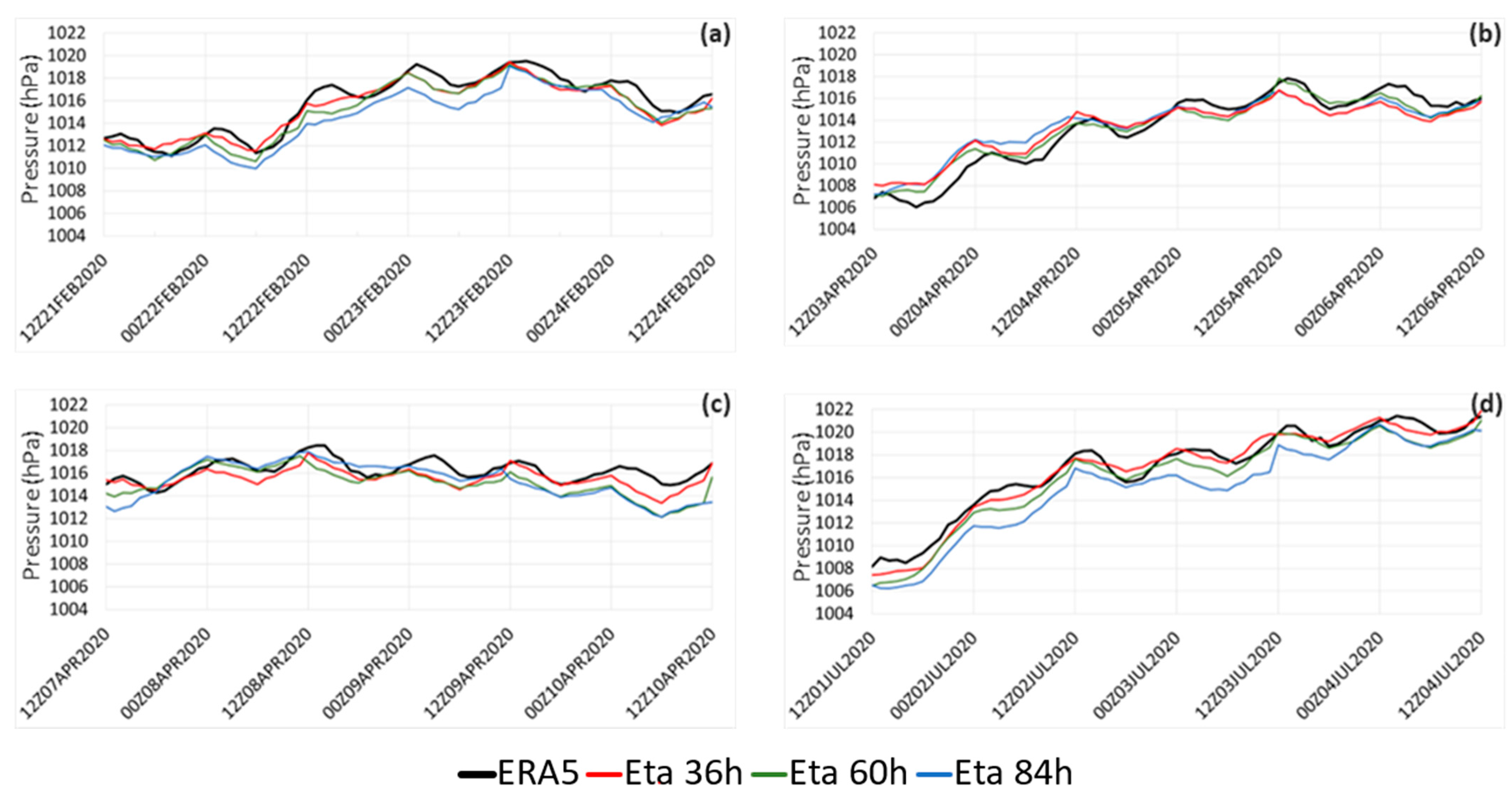
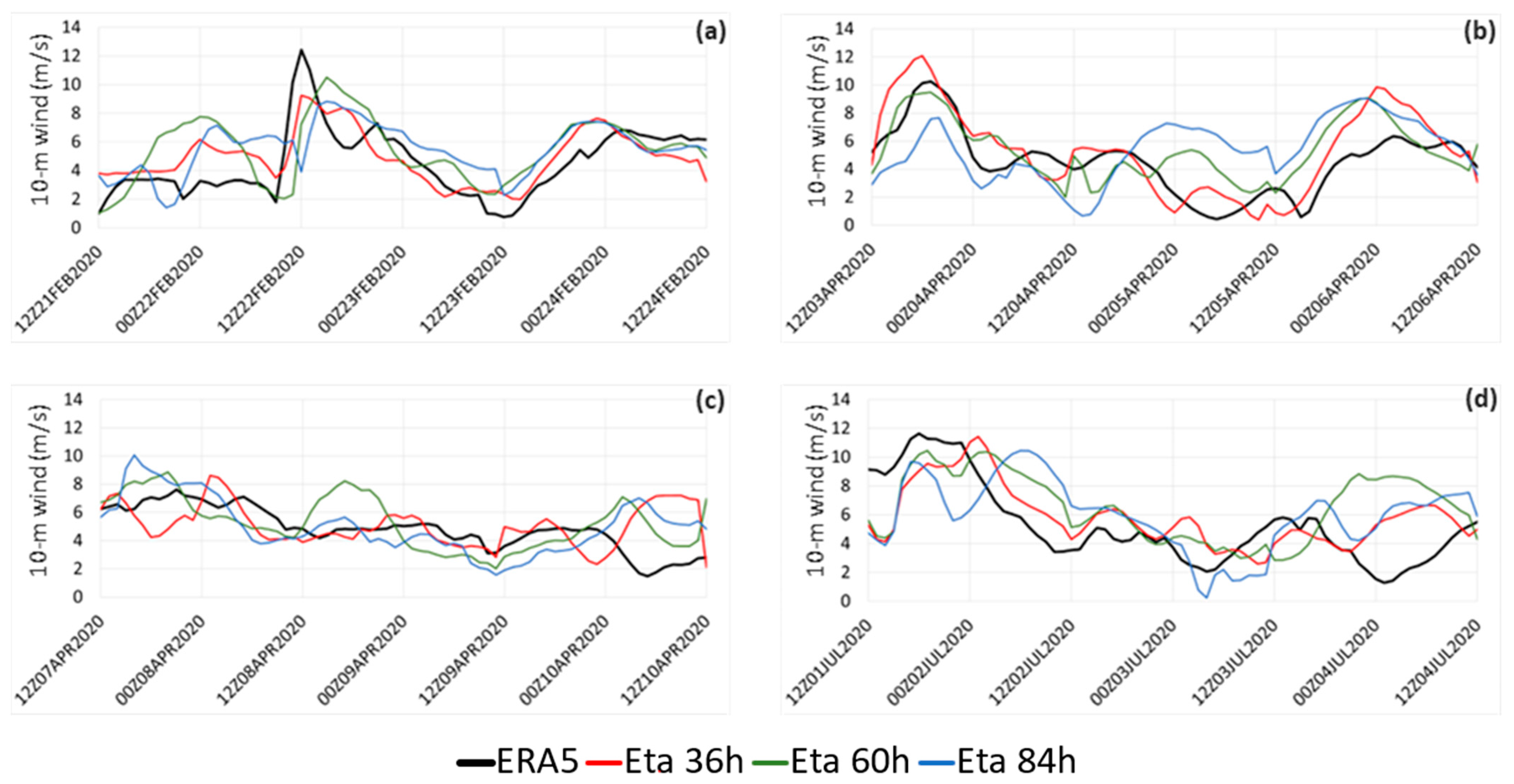



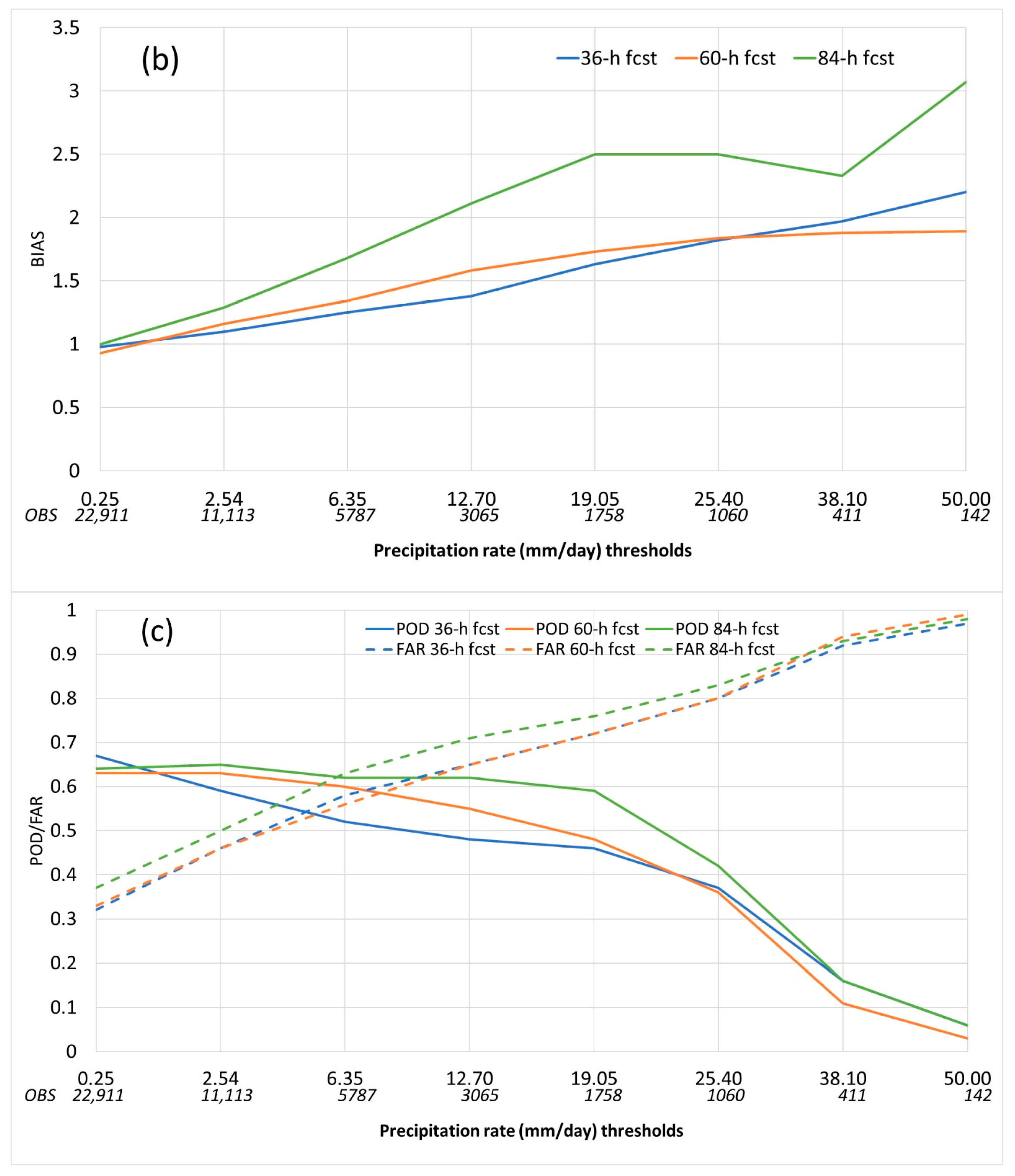
| Case # | Peak Date of the Event | Type of Storm Surge Event |
|---|---|---|
| 1 | 22 and 23 February 2020 | Storm tide + rough sea |
| 2 | 4 and 5 April 2020 | Storm tide + rough sea |
| 3 | 8 and 9 April 2020 | Storm tide + rough sea |
| 4 | 2 and 3 July 2020 | Rough sea |
Disclaimer/Publisher’s Note: The statements, opinions and data contained in all publications are solely those of the individual author(s) and contributor(s) and not of MDPI and/or the editor(s). MDPI and/or the editor(s) disclaim responsibility for any injury to people or property resulting from any ideas, methods, instructions or products referred to in the content. |
© 2024 by the authors. Licensee MDPI, Basel, Switzerland. This article is an open access article distributed under the terms and conditions of the Creative Commons Attribution (CC BY) license (https://creativecommons.org/licenses/by/4.0/).
Share and Cite
Chou, S.C.; Sondermann, M.; Chagas, D.J.; Gomes, J.L.; Souza, C.R.d.G.; Ruiz, M.S.; Sampaio, A.F.P.; Ribeiro, R.B.; Ferreira, R.S.; Silva, P.L.d.; et al. Four Storm Surge Cases on the Coast of São Paulo, Brazil: Weather Analyses and High-Resolution Forecasts. J. Mar. Sci. Eng. 2024, 12, 771. https://doi.org/10.3390/jmse12050771
Chou SC, Sondermann M, Chagas DJ, Gomes JL, Souza CRdG, Ruiz MS, Sampaio AFP, Ribeiro RB, Ferreira RS, Silva PLd, et al. Four Storm Surge Cases on the Coast of São Paulo, Brazil: Weather Analyses and High-Resolution Forecasts. Journal of Marine Science and Engineering. 2024; 12(5):771. https://doi.org/10.3390/jmse12050771
Chicago/Turabian StyleChou, Sin Chan, Marcely Sondermann, Diego José Chagas, Jorge Luís Gomes, Celia Regina de Gouveia Souza, Matheus Souza Ruiz, Alexandra F. P. Sampaio, Renan Braga Ribeiro, Regina Souza Ferreira, Priscila Linhares da Silva, and et al. 2024. "Four Storm Surge Cases on the Coast of São Paulo, Brazil: Weather Analyses and High-Resolution Forecasts" Journal of Marine Science and Engineering 12, no. 5: 771. https://doi.org/10.3390/jmse12050771







